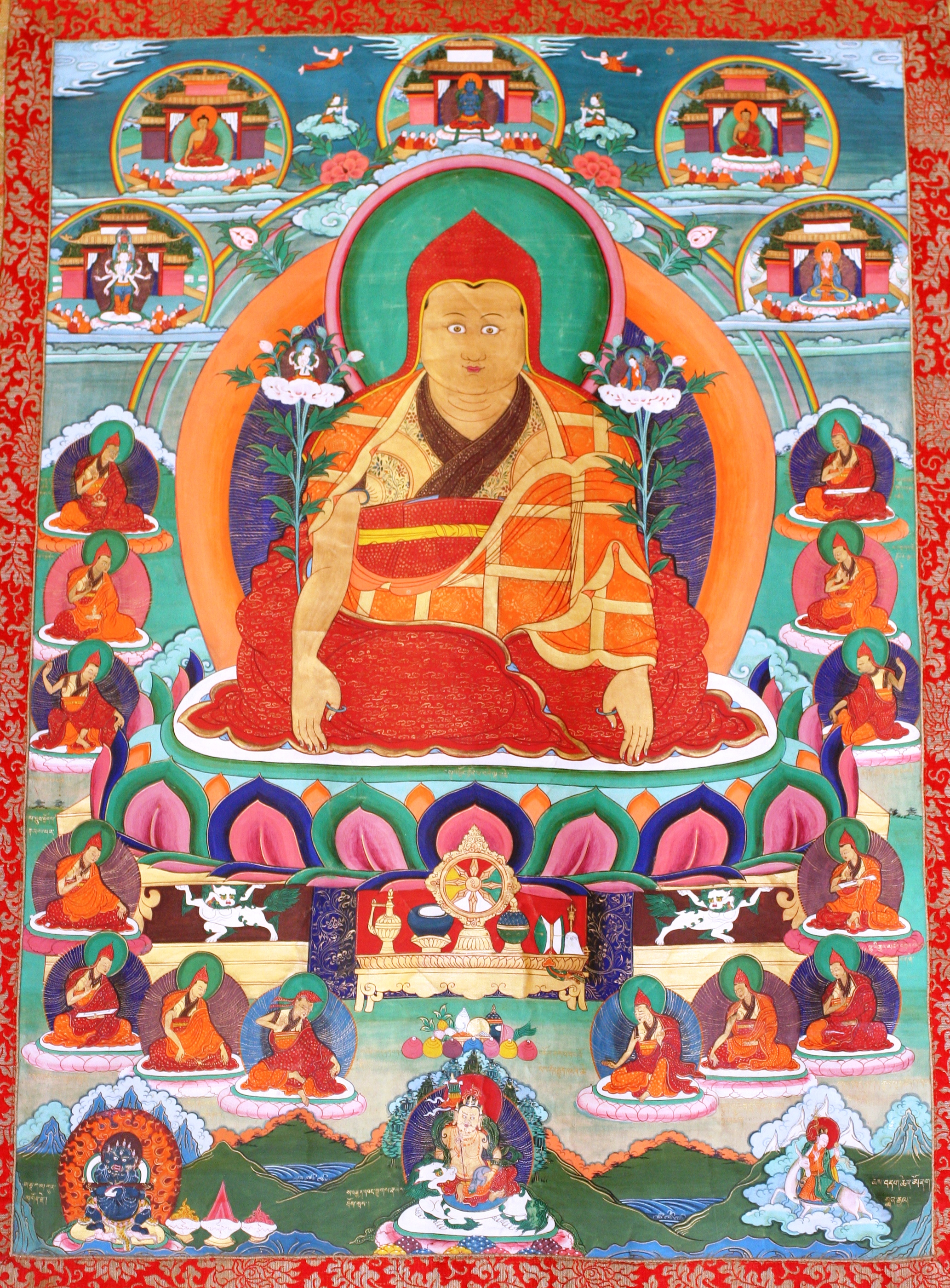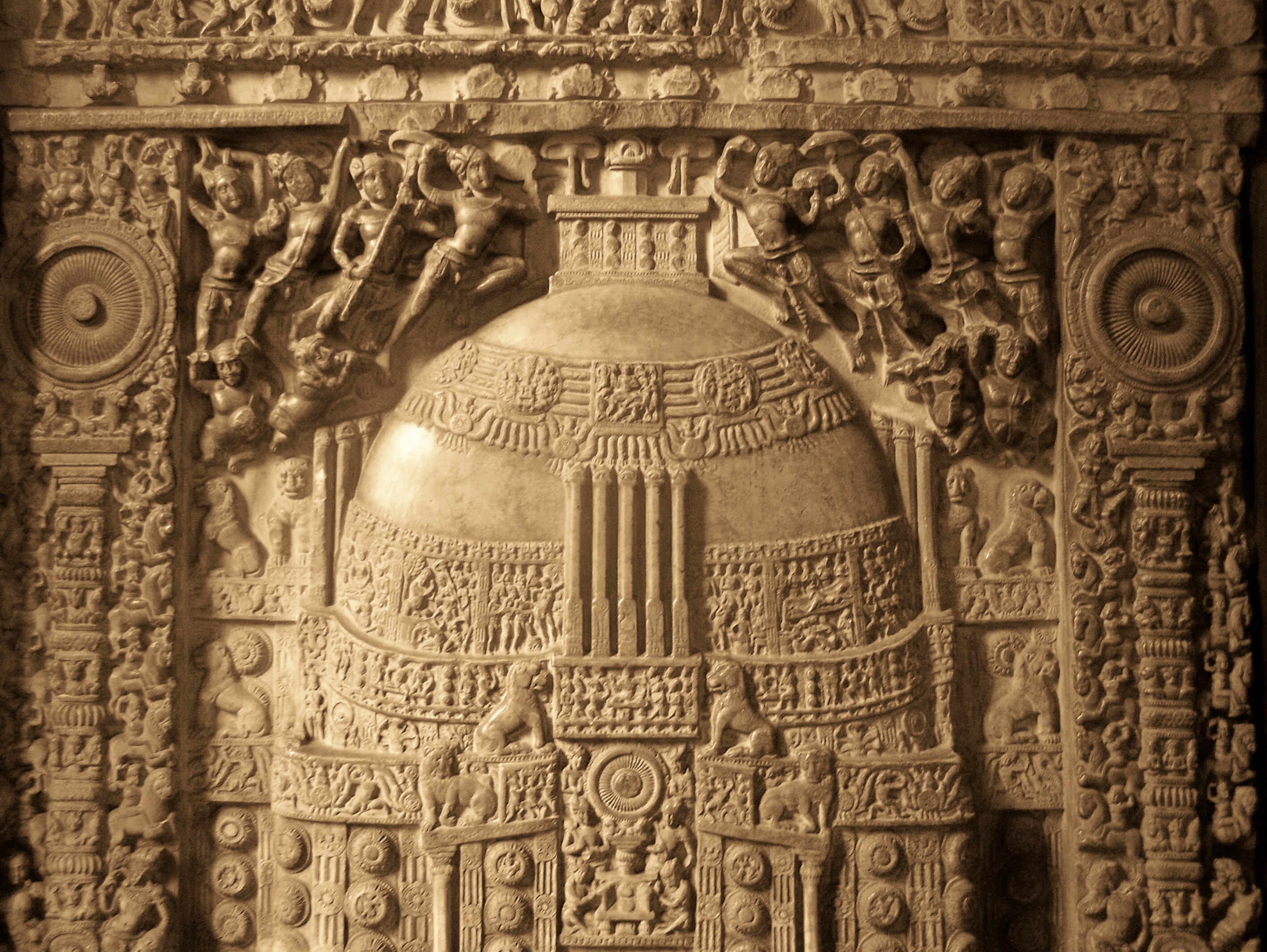|
Jonangpa
The Jonang () is one of the schools of Tibetan Buddhism. Its origins in Tibet can be traced to early 12th century master Yumo Mikyo Dorje, but became much wider known with the help of Dolpopa Sherab Gyaltsen, a monk originally trained in the Sakya school. The Jonang school’s main practice comes from the Kalachakra cycle. The Jonang re-established their religio-political center in Golok, Nakhi and Mongol areas of Kham and Amdo with the school's seat () at Dzamtang Tsangwa () dzong and have continued practicing uninterrupted to this day. An estimated 5,000 monks and nuns of the Jonang tradition practice today in these areas. However, their teachings were limited to these regions until the Rimé movement of the 19th century encouraged the study of non-Gelug schools of thought and practice.Gruschke 2001, p.72 History The monk Künpang Tukjé Tsöndrü (, 1243–1313) established a kumbum or stupa-vihara in the Jomonang Valley about northwest of the Tashilhunpo Monaste ... [...More Info...] [...Related Items...] OR: [Wikipedia] [Google] [Baidu] |
Dolpopa
Dölpopa Shérap Gyeltsen () (1292–1361), known simply as Dölpopa, was a Tibetan Buddhist master. Known as "The Buddha from Dölpo," a region in modern Nepal, he was the principal exponent of the shentong teachings, and an influential member of the Jonang tradition of Tibetan Buddhism. Biography Dölpopa was born in Dölpo. In 1309, when he was seventeen, he ran away from home to seek the Buddhist teachings, first in Mustang and then in Tibet. In 1314, when he was twenty-two years old, Dölpopa received full monastic ordination from the famous abbot of Choelung Monastery, Sönam Trakpa (1273–1352), and made a vow at the time to never eat slaughtered meat again. In 1321, Dölpopa visited Jonang Monastery at Jomonang (which was later destroyed during the Cultural Revolution) for the first time. He then visited Tsurphu Monastery for the first time and had extensive discussions with Rangjung Dorje, 3rd Karmapa Lama, about doctrinal issues. It appears that the Karmapa Lama ... [...More Info...] [...Related Items...] OR: [Wikipedia] [Google] [Baidu] |
Kalachakra
''Kālacakra'' () is a polysemic term in Vajrayana Buddhism that means " wheel of time" or "time cycles". "''Kālacakra''" is also the name of a series of Buddhist texts and a major practice lineage in Indian Buddhism and Tibetan Buddhism. The tantra is considered to belong to the unexcelled yoga ('' anuttara-yoga'') class. Kālacakra also refers both to a patron tantric deity or yidam in Vajrayana and to the philosophies and yogas of the Kālacakra tradition. The tradition's origins are in India and its most active later history and presence has been in Tibet. The tradition contains teachings on cosmology, theology, philosophy, sociology, soteriology, myth, prophecy, medicine and yoga. It depicts a mythic reality whereby cosmic and socio-historical events correspond to processes in the bodies of individuals. These teachings are meant to lead to a transformation of one's body and mind into perfect Buddhahood through various yogic methods. The Kālacakra tradition is based o ... [...More Info...] [...Related Items...] OR: [Wikipedia] [Google] [Baidu] |
Yumo Mikyo Dorje
Yumo Mikyö Dorjé () was a student of the Kashmiri scholar Somanātha and an 11th-century Kalachakra master. Yumo Mikyö Dorjé is regarded as one of the earliest Tibetan articulators of a shentong view of śūnyatā — an understanding of the absolute radiant nature of reality. Emphasized within the Kalachakra tantra and Gautama Buddha's teachings on Buddha-nature in the so-called Third Turning of the Wheel of the Dharma of the Yogacara school of Buddhism philosophy; this view later became emblematic of the Jonang tradition of Tibetan Buddhism Tibetan Buddhism (also referred to as Indo-Tibetan Buddhism, Lamaism, Lamaistic Buddhism, Himalayan Buddhism, and Northern Buddhism) is the form of Buddhism practiced in Tibet and Bhutan, where it is the dominant religion. It is also in maj .... External links Early Jonangpa in Tibet, Jonang Foundation Scholars of Buddhism from Tibet Jonang Lamas Tibetan Buddhist spiritual teachers Year of birth missing Year of dea ... [...More Info...] [...Related Items...] OR: [Wikipedia] [Google] [Baidu] |
Taranatha
Tāranātha (1575–1634) was a Lama of the Jonang school of Tibetan Buddhism. He is widely considered its most remarkable scholar and exponent. Taranatha was born in Tibet, supposedly on the birthday of Padmasambhava. His original name was Kun-dga'-snying-po, the Sanskrit equivalent of which is Anandagarbha. However, he adopted Taranatha, the Sanskrit name by which he was generally known, as an indication of the value he placed on his Sanskrit scholarship in an era when mastery of the language had become much less common in Tibet than it had once been. He was also paying homage to his Indian teacher, Buddhaguptanatha. His exceptional qualities are said to have been recognized by others at a young age, as is often the case with great masters. He studied under such masters as Je Draktopa, Yeshe Wangpo, Kunga Tashi and Jampa Lhundrup, although his primary teacher was Buddhaguptanatha. Taranatha was recognized by Khenchen Lungrik Gyatso as the rebirth of Krishnacarya and the Khe ... [...More Info...] [...Related Items...] OR: [Wikipedia] [Google] [Baidu] |
Śrīmālādevī Siṃhanāda Sūtra
The ''Śrīmālādevī Siṃhanāda Sūtra'' (, '' of Queen Śrīmālā'') is one of the main early Mahāyāna Buddhist texts belonging to the Tathāgatagarbha sūtras that teaches the doctrines of Buddha-nature and "One Vehicle" through the words of the Indian queen Śrīmālā. After its composition, this text became the primary scriptural advocate in India for the universal potentiality of Buddhahood. History Brian Edward Brown, a specialist in Buddha-nature doctrines, writes that the composition of the ''Śrīmālādevī Siṃhanāda Sūtra'' occurred during the Īkṣvāku Dynasty in the 3rd century CE as a product of the Caitika schools of the Mahāsāṃghikas. Alex Wayman has outlined eleven points of complete agreement between the Mahāsāṃghikas and the ''Śrīmālā'', along with four major arguments for this association. Anthony Barber also associates the earlier development of the ''Tathāgatagarbha Sūtra'' with the Mahāsāṃghikas, and concludes that the Ma ... [...More Info...] [...Related Items...] OR: [Wikipedia] [Google] [Baidu] |
Shentong
''Rangtong'' and ''shentong'' are two distinctive views on emptiness ( sunyata) and the two truths doctrine within Tibetan Buddhism. ''Rangtong'' (; "empty of self-nature") is a philosophical term in Tibetan Buddhism that is used to distinguish the majority Madhyamaka teaching on the meaning of śūnyatā or "emptiness", namely that all phenomena are empty of an enduring and/or unchanging essence or "self," and that this emptiness is not an absolute reality, but a mere nominal characterisation of phenomena. It is related to the '' prasangika'' approach, which argues that no syllogistic forms of reasoning should be used to debate the notion of inherent existence, but only arguments which show the logical implications and absurdity of positions based upon inherent existence. This position is the mainstream Gelugpa interpretation of Madhyamaka, one of the main Mahayana schools, which dominates Vajrayana Buddhism. ''Shentong'' (, also transliterated ''zhäntong'' or ''zhentong''; ... [...More Info...] [...Related Items...] OR: [Wikipedia] [Google] [Baidu] |
śūnyatā
''Śūnyatā'' ( sa, शून्यता, śūnyatā; pi, suññatā; ), translated most often as ''emptiness'', ''vacuity'', and sometimes ''voidness'', is an Indian philosophical concept. Within Hinduism, Jainism, Buddhism and other philosophical strands, the concept has multiple meanings depending on its doctrinal context. It is either an ontological feature of reality, a meditative state, or a phenomenological analysis of experience. In Theravāda Buddhism, ''Suññatā'' often refers to the non-self (Pāli: ''anattā'', Sanskrit: ''anātman'') nature of the five aggregates of experience and the six sense spheres. ''Suññatā'' is also often used to refer to a meditative state or experience. In Mahāyāna Buddhism, ''śūnyatā'' refers to the tenet that "all things are empty of intrinsic existence and nature ('' svabhava'')", but may also refer to the Buddha-nature teachings and primordial or empty awareness, as in Dzogchen, Shentong, or Chan. Etymology " ... [...More Info...] [...Related Items...] OR: [Wikipedia] [Google] [Baidu] |
Tathāgatagarbha Sūtra
The ''Tathāgatagarbha Sūtra'' is an influential and doctrinally striking Mahāyāna Buddhist scripture which treats of the existence of the "Tathāgatagarbha" (Buddha-Matrix, Buddha-Embryo, lit. "the womb of the thus-come-one") within all sentient creatures. According to the Buddha, all sentient beings are born with buddha-nature and have the potential to become a Buddha. Physical and mental defilements of everyday life act as clouds over the this nature and usually prevent this realization. This nature is no less than the indwelling Buddha himself. History Origins and development Anthony Barber associates the development of the ''Tathāgatagarbha Sūtra'' with the Mahāsāṃghika sect of Buddhism, and concludes that the Mahāsāṃghikas of the Āndhra region (i.e. the Caitika schools) were responsible for the inception of the Tathāgatagarbha doctrine. The ''Tathāgatagarbha Sūtra'' is considered "the earliest expression of this he tathāgatagarbha doctrineand the term '' ... [...More Info...] [...Related Items...] OR: [Wikipedia] [Google] [Baidu] |
Prajnaparamita Sutra
A Tibetan painting with a Prajñāpāramitā sūtra at the center of the mandala Prajñāpāramitā ( sa, प्रज्ञापारमिता) means "the Perfection of Wisdom" or "Transcendental Knowledge" in Mahāyāna and Theravāda Buddhism. Prajñāpāramitā refers to a perfected way of seeing the nature of reality, as well as to a particular body of Mahāyāna scriptures (sūtras) which discusses this wisdom. It also refers to the female deity Prajñāpāramitā Devi, a personification of wisdom also known as the "Great Mother" (Tibetan: ''Yum Chenmo''). The word ''Prajñāpāramitā'' combines the Sanskrit words '' prajñā'' "wisdom" (or "knowledge") with ''pāramitā'' "perfection" or " transcendent". Prajñāpāramitā is a central concept in Mahāyāna Buddhism and is generally associated with ideas such as emptiness (''śūnyatā''), 'lack of svabhāva' (essence), the illusory (''māyā'') nature of things, how all phenomena are characterized by "non-arisi ... [...More Info...] [...Related Items...] OR: [Wikipedia] [Google] [Baidu] |
Aṅgulimālīya Sūtra
The ''Aṅgulimālīya Sūtra'' ( Taishō 120) is a Mahāyāna Buddhist scripture belonging to the Tathāgatagarbha class of sūtra, which teach that the Buddha is eternal, that the non-Self and emptiness teachings only apply to the worldly sphere and not to Nirvāṇa, and that the Tathāgatagarbha is real and immanent within all beings and all phenomena. The sutra consists mostly of stanzas in verse. The Mahāyāna ''Aṅgulimālīya Sūtra'' should not be confused with the Pāli Canon's '' Angulimala Sutta'', which is a completely different work included in the Majjhima Nikaya. Origins and history According to Stephen Hodge, internal textual evidence in the ''Aṅgulimālīya Sūtra'', ''Mahābherihāraka Parivarta Sūtra'', and the ''Mahāyāna Mahāparinirvāṇa Sūtra'', indicates that these texts were first circulated in southern India, and they then gradually propagated up to the northwest, with Kashmir being the other major center. The ''Aṅgulimālīya Sūtra'' gi ... [...More Info...] [...Related Items...] OR: [Wikipedia] [Google] [Baidu] |
Mahāyāna Mahāparinirvāṇa Sūtra
The ''Mahāyāna Mahāparinirvāṇa Sūtra'' (Sanskrit; , ; Vietnamese: ''Kinh Đại Bát Niết Bàn'') or ''Nirvana Sutra'' is Mahāyāna Buddhist sutra of the Buddha-nature genre. Its precise date of origin is uncertain, but its early form may have developed in or by the second century CE. The original Sanskrit text is not extant except for a small number of fragments, but it survives in Chinese and Tibetan translation. The ''Nirvana sutra'' was translated into Chinese twice from two apparently substantially different source texts, with the 421 CE translation of Dharmakṣema being about four times longer than the 416 translation of Faxian (as well as the later Tibetan version).Jones, C. V. (2020) ''The Buddhist Self: On Tathāgatagarbha and Ātman,'' p. 30. University of Hawaiʻi Press. The two versions also differ in their teachings on Buddha-nature: Dharmakṣema's indicates all sentient beings have the potential to attain Buddhahood, but Faxian's states some will never ... [...More Info...] [...Related Items...] OR: [Wikipedia] [Google] [Baidu] |





.jpg)

